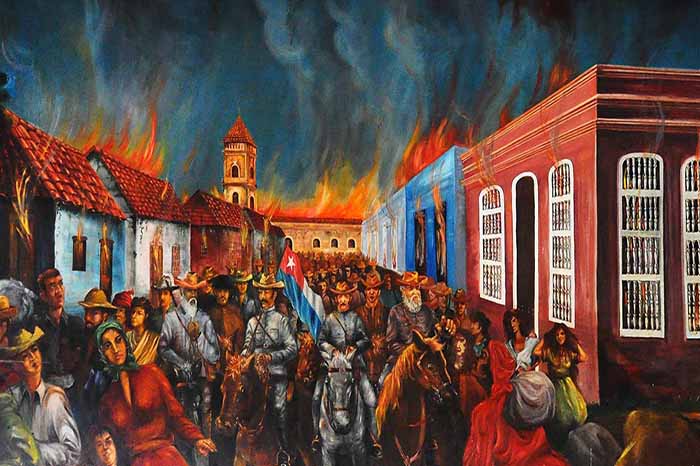
On January 12, 1869, some 85 days after the proclamation of the city of Bayamo as the capital of Free Cuba or the Republic in Arms, the residents of that heroic town set it on fire in order not to surrender it again to Spain after years of freedom and glory.
Such unprecedented event in colonial Cuba reinforced the decision of the mambises, who had been fighting since October 10, 1868 under Carlos Manuel de Céspedes’s command, to continue the struggle at any cost.
The cry of "Independence or death!" given by the local patrician—later known as the Father of the Homeland—when he freed the slaves of his sugar mill was not in vain: he would not surrender his free town to Blas de Villate, Count of Valmaseda, who led a troop of 2,700 well-armed soldiers who on their way to Bayamo were killing every peasant suspected of being a rebel.
The historic day of the emancipation of Bayamo witnessed the birth of a song that would become the National Anthem, sung by a vibrant and victorious people once its author, “Perucho” Figueredo, put lyrics and music together while riding through the crowd.
The dramatic decision to burn the town, made on January 12 as the Spaniard were approaching, must have been terrible and painful, as evidenced by some verses dedicated to the patriot Luz Vázquez y Moreno that reveal the intrepid and patriotic soul of the Cubans who were rising as a single people: "Your children burned you / There is no complaint / For it is better to die with honor than to serve the oppressive tyrant / Who wants to usurp our rights".
The fire started in the center of the town as more than 10,000 residents left everything behind and hurried to the mountains, where they suffered hunger, cold weather, disease and even death. Back home, only about 160 out of the town’s nearly thousand buildings remained standing. Graphic memory was lost as official stationery, public offices and temples, photos and long-cherished belongings of hundreds of families burned down.
However, the Bayamese kept fighting for freedom. Their sacrifice sealed the fate of the town that one day became Cuba’s first city to be declared National Monument.
When the Count of Valmaseda arrived and found nothing but smoldering remains, his vindictive fury led him to torture whoever he could capture, as in the case of Adriana del Castillo, a 16-year-old born to patriots who was sick with typhus. She is said to have refused to be treated by a Spanish doctor and died singing the National Anthem.
“Perucho” Figueredo, who had reached the rank of General of the Liberation Army, was eventually captured by the Spaniards. Riddled with disease and unable to defend himself, he was shot in a dungeon in the city of Santiago de Cuba.
Although Bayamo had been a thriving town thanks to the slave trade, its citizens, including the wealthy, had fewer rights than the colonialists, who had implemented semi-feudal and tyrannical methods of governance. As a result, it became a hotbed of political, emancipatory and revolutionary activity led by Francisco Vicente Aguilera, Carlos Manuel de Céspedes, Pedro Figueredo, Francisco Maceo Osorio, Donato Mármol and others who entered the list of Cuba’s founding fathers.
The memory of the Bayamo fire lives on as a glare that illuminates Cuba’s new life, in the making since January 1st, 1959 in a city that was reborn and is willing to contribute decisively to the progress and development of its homeland. Honor and glory to Bayamo!










Nos reservamos el derecho de no publicar los comentario que incumplan con las normas de este sitio